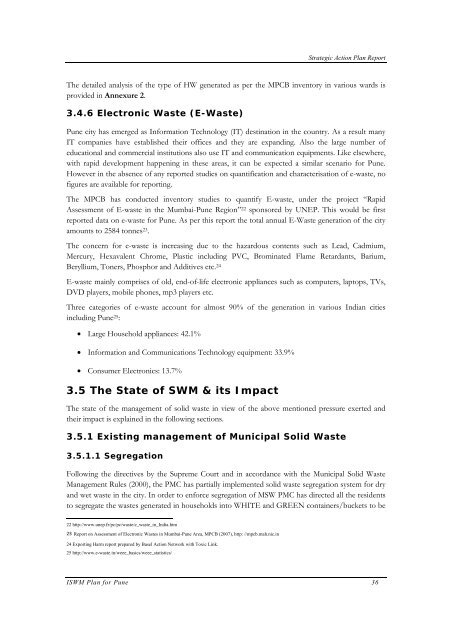Strategic Action Plan - International Environmental Technology Centre
Strategic Action Plan - International Environmental Technology Centre
Strategic Action Plan - International Environmental Technology Centre
You also want an ePaper? Increase the reach of your titles
YUMPU automatically turns print PDFs into web optimized ePapers that Google loves.
<strong>Strategic</strong> <strong>Action</strong> <strong>Plan</strong> Report<br />
The detailed analysis of the type of HW generated as per the MPCB inventory in various wards is<br />
provided in Annexure 2.<br />
3.4.6 Electronic Waste (E-Waste)<br />
Pune city has emerged as Information <strong>Technology</strong> (IT) destination in the country. As a result many<br />
IT companies have established their offices and they are expanding. Also the large number of<br />
educational and commercial institutions also use IT and communication equipments. Like elsewhere,<br />
with rapid development happening in these areas, it can be expected a similar scenario for Pune.<br />
However in the absence of any reported studies on quantification and characterisation of e-waste, no<br />
figures are available for reporting.<br />
The MPCB has conducted inventory studies to quantify E-waste, under the project “Rapid<br />
Assessment of E-waste in the Mumbai-Pune Region” 22 sponsored by UNEP. This would be first<br />
reported data on e-waste for Pune. As per this report the total annual E-Waste generation of the city<br />
amounts to 2584 tonnes 23 .<br />
The concern for e-waste is increasing due to the hazardous contents such as Lead, Cadmium,<br />
Mercury, Hexavalent Chrome, Plastic including PVC, Brominated Flame Retardants, Barium,<br />
Beryllium, Toners, Phosphor and Additives etc. 24<br />
E-waste mainly comprises of old, end-of-life electronic appliances such as computers, laptops, TVs,<br />
DVD players, mobile phones, mp3 players etc.<br />
Three categories of e-waste account for almost 90% of the generation in various Indian cities<br />
including Pune 25 :<br />
• Large Household appliances: 42.1%<br />
• Information and Communications <strong>Technology</strong> equipment: 33.9%<br />
• Consumer Electronics: 13.7%<br />
3.5 The State of SWM & its Impact<br />
The state of the management of solid waste in view of the above mentioned pressure exerted and<br />
their impact is explained in the following sections.<br />
3.5.1 Existing management of Municipal Solid Waste<br />
3.5.1.1 Segregation<br />
Following the directives by the Supreme Court and in accordance with the Municipal Solid Waste<br />
Management Rules (2000), the PMC has partially implemented solid waste segregation system for dry<br />
and wet waste in the city. In order to enforce segregation of MSW PMC has directed all the residents<br />
to segregate the wastes generated in households into WHITE and GREEN containers/buckets to be<br />
22 http://www.unep.fr/pc/pc/waste/e_waste_in_India.htm<br />
23 Report on Assessment of Electronic Wastes in Mumbai-Pune Area, MPCB (2007), http: //mpcb.mah.nic.in<br />
24 Exporting Harm report prepared by Basel <strong>Action</strong> Network with Toxic Link.<br />
25 http://www.e-waste.in/weee_basics/weee_statistics/<br />
ISWM <strong>Plan</strong> for Pune 36
















